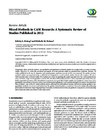| dc.contributor.author | Bishop, Felicity L | |
| dc.contributor.author | Holmes, Michelle | |
| dc.date.accessioned | 2023-12-04T11:49:42Z | |
| dc.date.available | 2023-12-04T11:49:42Z | |
| dc.date.issued | 2013-12-22 | |
| dc.identifier.citation | Bishop, F. L., & Holmes, M. M. (2013). Mixed methods in CAM research: a systematic review of studies published in 2012. Evidence-based complementary and alternative medicine, 2013, 187365. https://doi.org/10.1155/2013/187365 | en |
| dc.identifier.issn | 1741-427X | |
| dc.identifier.uri | https://aecc.archive.knowledgearc.net/handle/123456789/206 | |
| dc.description | Available under License - Creative Commons Attribution: https://creativecommons.org/licenses/by/4.0/ | en |
| dc.description.abstract | Background: Mixed methods research uses qualitative and quantitative methods together in a single study or a series of related studies. Objectives: To review the prevalence and quality of mixed methods studies in complementary medicine. Methods: All studies published in the top 10 integrative and complementary medicine journals in 2012 were screened. The quality of mixed methods studies was appraised using a published tool designed for mixed methods studies. Results. 4% of papers (95 out of 2349) reported mixed methods studies, 80 of which met criteria for applying the quality appraisal tool. The most popular formal mixed methods design was triangulation (used by 74% of studies), followed by embedded (14%), sequential explanatory (8%), and finally sequential exploratory (5%). Quantitative components were generally of higher quality than qualitative components; when quantitative components involved RCTs they were of particularly high quality. Common methodological limitations were identified. Most strikingly, none of the 80 mixed methods studies addressed the philosophical tensions inherent in mixing qualitative and quantitative methods. Conclusions and Implications: The quality of mixed methods research in CAM can be enhanced by addressing philosophical tensions and improving reporting of (a) analytic methods and reflexivity (in qualitative components) and (b) sampling and recruitment-related procedures (in all components). | en |
| dc.language.iso | en | en |
| dc.publisher | Evidence-Based Complementary and Alternative Medicine | en |
| dc.title | Mixed methods in CAM research: a systematic review of studies published in 2012 | en |
| dc.type | Article | en |
| dc.identifier.doi | https://doi.org/10.1155/2013/187365 | |
